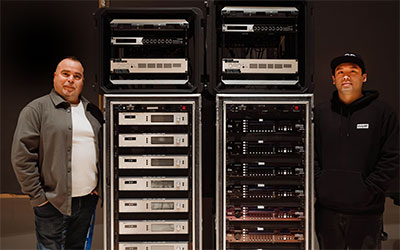Since opening its doors in 2004, the Rose Hall at the Jazz at Lincoln Center complex in New York has been the nerve centre for the prestigious organistion’s performance, archival recording and educational programming efforts. Recently, it has seen the installation of an intricate, modular audio production system built around DAD AX64 Next-Gen AD/DA/DD and audio routing interfaces to provide the quality and flexibility requires to preserve the music JALC champions for future generations while also offering audiences new performances.
Installed by Amplified Art & Sound LLC– JALC’s exclusive audio recording and mixing provider – this comprises six DAD AX64 interfaces, three Avid MTRX/DAD AX32 Pro Tools Interfaces, an Avid/DAD MTRX Studio, a DADCore 256, a Penta 721s and a DAD MOM, alongside JALC’s existing collection of preamps and converters. These are accommodated in a series of mobile racks that can be moved in and out of any performance or recording space. Audio is networked via Dante for flexibility in recording venue and output necessity.
 The Amplified Art & Sound Team comprises owner and Chief Engineer, Todd Whitelock, Studio Manager Barry Bongiovi, Technical Engineer Christopher Gold and Assistant Engineer Tiger Diep who share responsibility when it comes to the audio production needs of the JALC.
The Amplified Art & Sound Team comprises owner and Chief Engineer, Todd Whitelock, Studio Manager Barry Bongiovi, Technical Engineer Christopher Gold and Assistant Engineer Tiger Diep who share responsibility when it comes to the audio production needs of the JALC.
Initially brought on to serve as audio archivist for JALC’s 25-year plus archive of live recordings and postproduction of the same, Whitelock also engineers frontline recordings for their in-house Blue Engine Records label. The team’s responsibilities have evolved to place an increased emphasis on broadcast and live streaming as a way to capture the next generation of jazz aficionados.
‘I’ve had the privilege of being in the orbit of Wynton [Marsalis] since the mid-90s and archiving the performances at JALC in the highest possible fidelity has been his top priority from the beginning,’ Whitelock says. ‘Preserving this music for future generations is incredibly important, and we’ve designed our audio infrastructure to allow us to do that in every stage and studio space in Rose Hall.
‘That initial impulse ultimately served us well once webcasting and live broadcast became steadily more important to reach a wider audience. Wynton saw an opportunity to advance the art while also providing a new way for audiences to engage with this music through the Jazz Live site.’
The audio production capabilities of JALC’s studios have continued to grow organically in response to these priorities. ‘We’re recording across three stages, a recording studio, and two control rooms and need a system that can be deployed in any of these areas – or any combination therein – quickly, while offering the highest level of quality and reliability possible,’ Whitelock explains. ‘As we moved to upgrade JALC’s systems, the DAD AX64 interfaces became an increasingly important design element in our workflow. The spinal cord really.
‘The recording of jazz music was not typically handled in a state-of-the-art way,’ he continues. ‘A big difference in what we do here is our approach to fidelity and the accuracy of acoustic capture because we know it has an impact on how the audience perceives this music in a contemporary context. Wynton wants to engage the listener at home as if they were attending the concert.
‘Individual clarity, tone, and musicality is critical when capturing these performances – you want to be able to hear each player and feel their presence in a live jazz recording for it to be effective. The technology of the converters in the AX64 lifts the veil on this music, and does right by the musicians. Capturing the complete harmonic series of the music and the acoustic space around it allows you to feel the energy and excitement of a performance while having a natural separation that was not previously possible.’
The energy and excitement of a performance is at its fullest on sessions where Amplified Art & Sound is recording Wynton Marsalis and the Jazz at Lincoln Center Orchestra. Some of Marsalis’ pieces for Symphony Orchestra, Jazz big band and choir are on such scale that can require a large number of inputs – met by the DAD architecture that allows recording of up to 160 inputs. Here, the flexibility and reliability of the Dante-networked audio gives the team the most streamlined workflow possible to capture the ensemble at its finest.
‘There’s nothing more powerful than a big band – it’s like a locomotive and you want the recorded audio and livestream to reflect those dynamics,’ Whitelock says. ‘The DAD converters deliver on that wholly, and having the connectivity over IP to use it in any configuration we need is a game changing. It’s a lot of flexibility that was not there before and the possibilities really seem infinite.’
More: www.digitalaudio.dk

